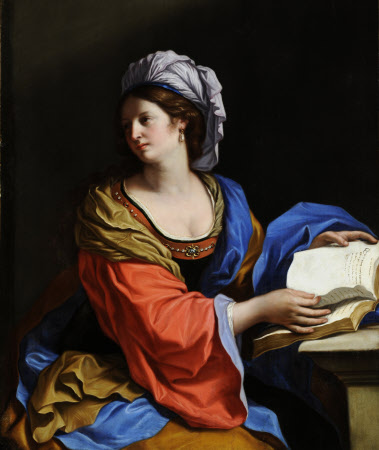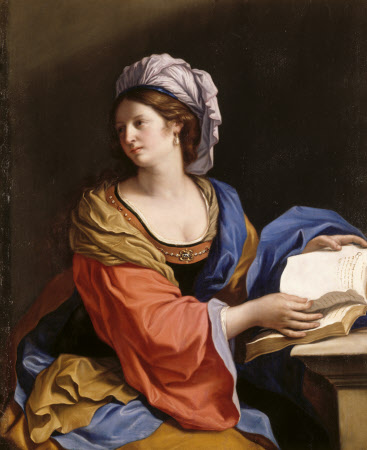The Cumaean Sibyl
studio of Guercino (Cento 1591 – Bologna 1666)
Category
Art / Oil paintings
Date
1591 - 1666
Materials
Oil on canvas
Measurements
1170 x 920 mm
Place of origin
Italy
Order this imageCollection
Nostell Priory, West Yorkshire
NT 960075
Summary
Oil painting in canvas, The Cumaean Sibyl, studio of Guercino (Cento 1591 – Bologna 1666). The twelve pagan sibyls, or Apollo's classical priestesses at Delphi, endowed with the gift of prophecy, were accepted by the Christian church as pagan counterparts of the Old Testament prophets, foretelling the coming of Christ. This Sybil holds one of the ‘Sibylline Books', in which her prophecies were recorded. The Cumaean Sibyl predicted that Christ would be born of a virgin in a stable at Bethlehem. The inscription on the stone slab of the original painting refers to the cross on which Christ was crucified. This painting, originally known as 'The Persian Sybil', is in fact a very fine copy and a reduced version from Guercino's much larger painting 'The Cumaean Sybil with a Putto' of 1651 ex-Sir Denis Mahon collection, hanging in the National Gallery, London which was commissioned in 1651 by Gioseffo Locatelli of Cesena as a companion to a King David (Spencer collection; Althorp). Before the Sibyl could be sent to Locatelli though, it was seen in Guercino’s studio by Prince Mattias de' Medici, who convinced the artist to sell it to him. Guercino then painted a replacement for Locatelli: a Samian Sibyl with a Putto ex-Spencer collection, and now in the National Gallery. The present painting was acquired by Charles Winn as a ‘Persian Sibyl', from a dealer or at auction in London in 1834 and stored with the decorator, Thomas Ward of 27, Frith Street, Soho, before being sent on to Nostell.
Provenance
Possibly the “Sibyl purchased from S. Jennings on 17 September 1823 for £35, or the ‘Persian Sibyl' acquired by Charles Winn from a dealer or at auction in London in 1834 and stored with the decorator, Thomas Ward of 27 Frith Street, Soho, before being sent on to Nostell Priory; purchased by National Trust with funding from the Heritage Lottery Fund in 2002
Credit line
Nostell Priory, The St Oswald Collection (National Trust)
Makers and roles
studio of Guercino (Cento 1591 – Bologna 1666) , artist previously catalogued as attributed to Italian (Bolognese) School, artist
References
Brockwell 1915 Maurice Walter Brockwell, Catalogue of the Pictures and Other Works of Art in the Collection of Lord St Oswald at Nostell Priory, London 1915, cat. 271

